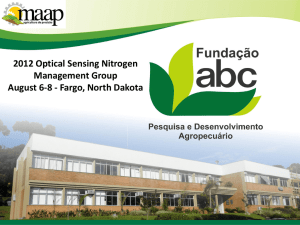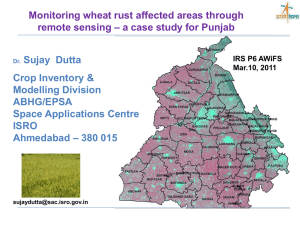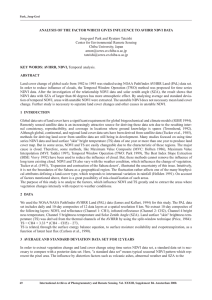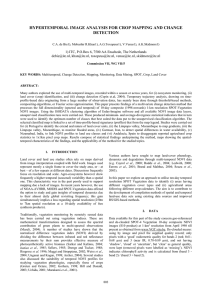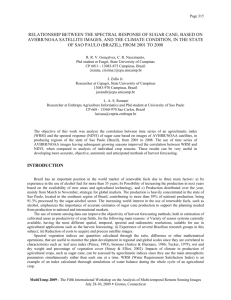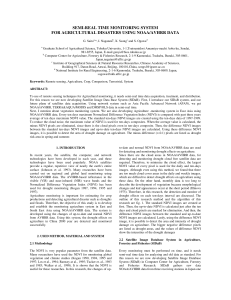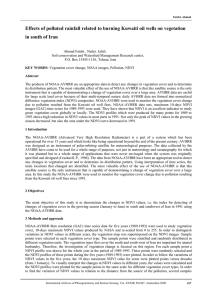Spencer Zaputil Geography 342 12-15
advertisement
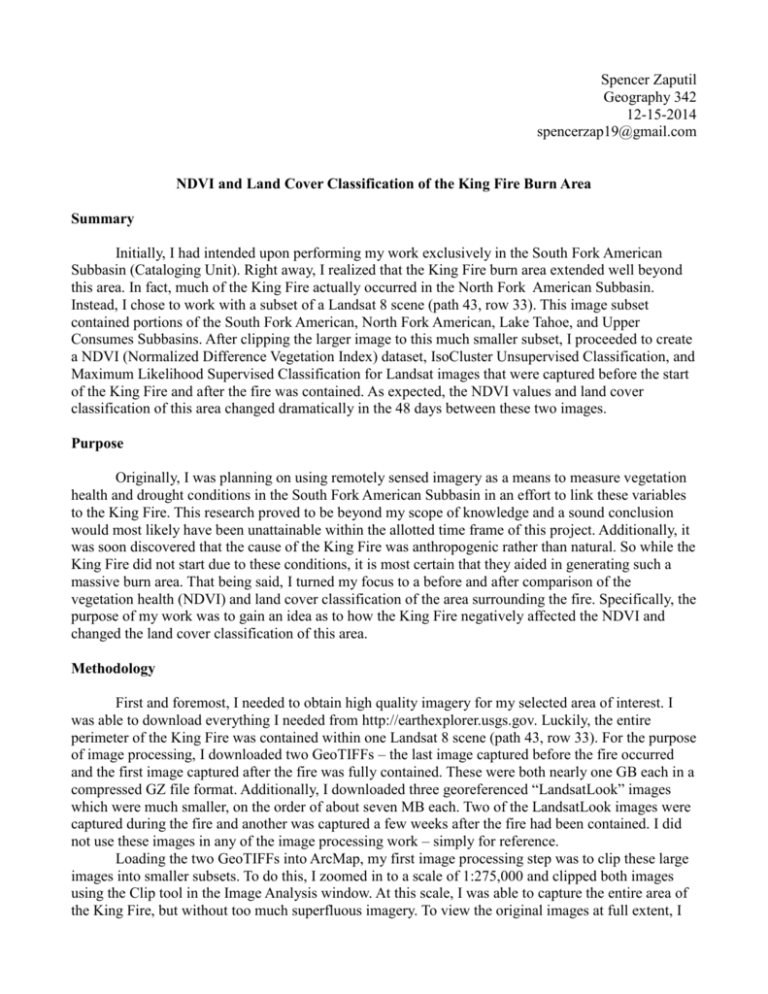
Spencer Zaputil Geography 342 12-15-2014 spencerzap19@gmail.com NDVI and Land Cover Classification of the King Fire Burn Area Summary Initially, I had intended upon performing my work exclusively in the South Fork American Subbasin (Cataloging Unit). Right away, I realized that the King Fire burn area extended well beyond this area. In fact, much of the King Fire actually occurred in the North Fork American Subbasin. Instead, I chose to work with a subset of a Landsat 8 scene (path 43, row 33). This image subset contained portions of the South Fork American, North Fork American, Lake Tahoe, and Upper Consumes Subbasins. After clipping the larger image to this much smaller subset, I proceeded to create a NDVI (Normalized Difference Vegetation Index) dataset, IsoCluster Unsupervised Classification, and Maximum Likelihood Supervised Classification for Landsat images that were captured before the start of the King Fire and after the fire was contained. As expected, the NDVI values and land cover classification of this area changed dramatically in the 48 days between these two images. Purpose Originally, I was planning on using remotely sensed imagery as a means to measure vegetation health and drought conditions in the South Fork American Subbasin in an effort to link these variables to the King Fire. This research proved to be beyond my scope of knowledge and a sound conclusion would most likely have been unattainable within the allotted time frame of this project. Additionally, it was soon discovered that the cause of the King Fire was anthropogenic rather than natural. So while the King Fire did not start due to these conditions, it is most certain that they aided in generating such a massive burn area. That being said, I turned my focus to a before and after comparison of the vegetation health (NDVI) and land cover classification of the area surrounding the fire. Specifically, the purpose of my work was to gain an idea as to how the King Fire negatively affected the NDVI and changed the land cover classification of this area. Methodology First and foremost, I needed to obtain high quality imagery for my selected area of interest. I was able to download everything I needed from http://earthexplorer.usgs.gov. Luckily, the entire perimeter of the King Fire was contained within one Landsat 8 scene (path 43, row 33). For the purpose of image processing, I downloaded two GeoTIFFs – the last image captured before the fire occurred and the first image captured after the fire was fully contained. These were both nearly one GB each in a compressed GZ file format. Additionally, I downloaded three georeferenced “LandsatLook” images which were much smaller, on the order of about seven MB each. Two of the LandsatLook images were captured during the fire and another was captured a few weeks after the fire had been contained. I did not use these images in any of the image processing work – simply for reference. Loading the two GeoTIFFs into ArcMap, my first image processing step was to clip these large images into smaller subsets. To do this, I zoomed in to a scale of 1:275,000 and clipped both images using the Clip tool in the Image Analysis window. At this scale, I was able to capture the entire area of the King Fire, but without too much superfluous imagery. To view the original images at full extent, I needed to zoom out to a scale of 1:1,500,000, so I had clipped the images down to about 20% of their original size. This helped out tremendously in the subsequent image processing steps. After creating the two temporary subset images, I saved these as permanent images with shorter names. Below are screenshots of these two images. My next step was to create NDVI datasets from the two subset images. I attempted this through use of the NDVI tool in the Image Analysis window. I tried to complete this simple task about five times with the saved subset images, but without fail, ArcMap crashed every single time. I even tried restarting my computer, but it kept happening. Going out on a limb, I attempted the same process with the temporary subset images files, and miraculously, it worked! Kind of. Below is a screenshot of the resulting NDVI image. As you can see above, the only feature that is even remotely distinguishable is the west shore of Lake Tahoe in the northeast corner of the image. Nonetheless, I copied this image and stretched it into grayscale via the Symbology tab of the Layer Properties. Below is a screenshot of the resulting grayscale version of the above image. At least the features are distinguishable in the above image, but that is not to say that this image is correct by any means. The lighter areas should show areas with high NDVI values, whereas the darker areas should show areas with low NDVI values. As seen above, the King Fire burn scar, Desolation Wilderness, the American Fire burn scar, deforested plots, and the receding shorelines of the nearby lakes and reservoirs all appear very light, if not white. This is the exact opposite of how these features should appear. Switching gears, I attempted to create NDVI datasets by using the Raster Calculator tool. In order to accomplish this task, I had to bring in the individual red and near-infrared bands for the two subset images. This worked out much better. Below is a screenshot of the pre-fire NDVI image. As seen above, the forest is correctly identified as having higher NDVI values (lighter areas), whereas the American Fire burn scar, Desolation Wilderness, and the water bodies have lower (darker) NDVI Values. Below is a screenshot of the post-fire NDVI image. The above image is leaps and bounds better than my first attempt at creating a NDVI dataset for the post-fire image. Here, the burn scar for the King Fire is correctly identified and sticks out as the most prominent feature in the image. In comparison to the American Fire burn scar at the top of the image, you can tell that this fire was much more recent due to its dark coloration, which indicates that the forest has not begun to grow back yet. My next step was to perform IsoCluster Unsupervised Classifications on the two subset images. Using ten classes, the default sample interval of ten, and a minimum class size of 80 (ten times the number of bands), the following classification was produced for the pre-fire image. Using the same parameters, the following classification was created for the post-fire image. After creating the two images above, I attempted to reclassify them in pseudo-true color classification schemes according to what I interpreted the classes to represent. Below are screenshots of these two reclassification attempts. I was especially happy with how the pre-fire unsupervised classification image turned out. This image looks pretty good in comparison to the original image with a true-color band ratio. I was not quite as pleased with the unsupervised classification of the post-fire image. As you can see above, ArcMap classified some of the canyon walls and other dark features as being water. Otherwise, the rest of the image was classified pretty well. The King Fire burn scar is very apparent in this image. In an attempt to do better than ArcMap, I tried to perform a Maximum Likelihood Supervised Classification on my own. Needless to say, ArcMap won this battle hands down, and did it in a fraction of the time. Below are screenshots of my attempts at performing Maximum Likelihood Supervised Classifications on the two image subsets. After creating the two Supervised Classification images seen above, I proceeded to recode the two output images into pseudo-true color images using the Reclassify tool. Below are screenshots of my attempts at this task. As seen above, there is a weird brown blotch in the southern portion of Lake Tahoe. I am unsure as to why this area of the lake was classified in this fashion, but I do know that it is being displayed in the color that I had reclassified as being previously burned based off of the burn scar from the American Fire at the top of the image. As well, too much of the image was classified as being barren or deforested. Again, way too much of the image was classified as being barren or deforested, and not nearly enough was classified as forest or other vegetation. On a positive note, the King Fire burn scar can be clearly seen in this image and there is no strange brown blotch in the waters of Lake Tahoe. Conclusions The King Fire left its mark on both the NDVI values and land cover classification of the area through which it burned. This is readily apparent in many of the previous images. Also, I learned that ArcMap is better at classifying land cover than I will ever be.

